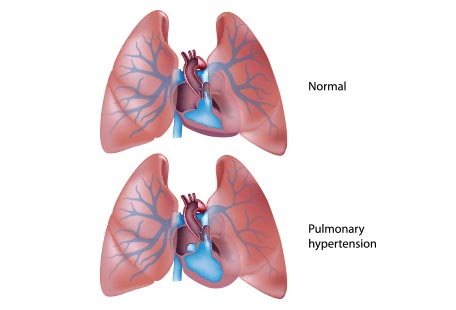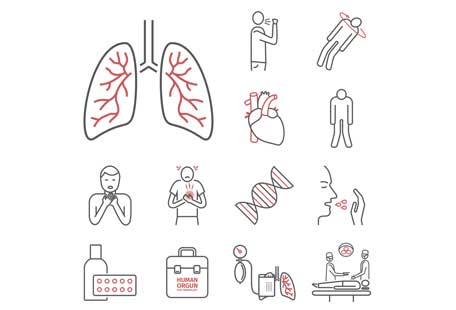Pulmonary Hypertension

 About Pulmonary Hypertension
About Pulmonary Hypertension
Pulmonary Hypertension Is a progressive disease that reduces blood flow and increases pressure in the arteries of the lungs.
 The pulmonary arteriesare the large blood vessels responsible for transporting blood from the heart to the lungs to pick up oxygen.
The pulmonary arteriesare the large blood vessels responsible for transporting blood from the heart to the lungs to pick up oxygen. In Path: The cells lining the inside of these arteries enlarge and multiply.
In Path: The cells lining the inside of these arteries enlarge and multiply. As a result: The walls of the arteries may narrowand thicken.
As a result: The walls of the arteries may narrowand thicken. CausingIng: Prevent blood flowing through them and so increasing blood pressure.
CausingIng: Prevent blood flowing through them and so increasing blood pressure.
 Pulmonary Hypertension SYMPTOMS
Pulmonary Hypertension SYMPTOMS
People with pulmonary hypertension experience a range of symptoms that vary in intensity depending on the severity of their condition.
Common symptoms:
 Breathlessness
Breathlessness excessive fatigue
excessive fatigue dizziness especially when climbing stairs
dizziness especially when climbing stairs fainting
fainting weakness upon physical exertion
weakness upon physical exertion chest pain, especially during physical activity-palpitations
chest pain, especially during physical activity-palpitations swollen legs and ankles
swollen legs and ankles cough
cough As the right heart fails
As the right heart fails
- Worsening breathlessness
- worsening fatigue
- marked ankle oedema
- throbbing sensation felt in the neck
- feeling of fullness in the abdomen
- lips and fingernails may take on a bluish tint


 Causes of PAH
Causes of PAH
 Connective tissue disease (e.g., scleroderma, lupus, or rheumatoid arthritis)
Connective tissue disease (e.g., scleroderma, lupus, or rheumatoid arthritis) Cirrhosis of the liver
Cirrhosis of the liver HIV infection
HIV infection Methamphetamine and cocaine
Methamphetamine and cocaine Congenital heart defects
Congenital heart defects Rarely, an inherited disease
Rarely, an inherited disease
 Diagnosis & Treatment of PAH
Diagnosis & Treatment of PAH
 PAH is not often diagnosed easily because its early symptoms can be confused with those of other cardio-respiratory conditions. Symptoms can initially be subtle and relatively non-specific.
PAH is not often diagnosed easily because its early symptoms can be confused with those of other cardio-respiratory conditions. Symptoms can initially be subtle and relatively non-specific.
 Diagnosis
Diagnosis
If Your doctor suspects that you may have PAH, then he will order tests to see if there is a strain on the right side of yourheart.
- Electrocardiogram
- Chest X ray
- Pulmonary function tests
- Echocardiograph (ultrasound of your heart )
- Ventilation lung scan
- Abdominal ultrasound scan
 Treatment
Treatment
Oral anticoagulation (pills for thinning the blood):
- Diuretics (pills for removing water)
- Oxygen treatment
Calcium channel blockers (pills): only for patients who respond to the acute vaso-reactive test performed.
- Synthetic prostacyclin and analogous prostacyclin
- Endothelin receptor antagonists (Pills)
- PDE-5 inhibitors (pills)
 DO’s and DON’Ts
DO’s and DON’Ts
 Asthma can’t be cured, but its symptoms can be controlled. Because asthma often changes over time, it’s important that you work with your doctor to track your signs and symptoms and adjust treatment as needed.
Asthma can’t be cured, but its symptoms can be controlled. Because asthma often changes over time, it’s important that you work with your doctor to track your signs and symptoms and adjust treatment as needed.
The key to living with asthma successfully is to keep it under control. Limit contact with asthma triggers in your environment, monitor your condition with a peak flow meter, and follow your treatment plan strictly.
Work on reducing asthma triggers. A first step is to stop smoking and protect yourself second-hand smoke in your home and in public places.
It is possible to be active and stay healthy when you’re living with asthma. In fact, many medal-winning Olympic athletes have asthma. Exercise strengthens your respiratory muscles, helps maintain weight.Exercises that are less likely to trigger asthma symptoms include swimming, walking, hiking, and leisurely biking. Sports that have short bursts of activity are also less likely to set off symptoms. Examples include baseball, football, and sprinting.
You may have to pace yourself at times or make some adjustments here or there, such as avoiding outdoor sports in the early morning, when pollen counts are at their highest (assuming pollen is one of your triggers).
Stress can be a trigger for asthma attacks. With that in mind, commit to implementing stress-reduction strategies into your life, such as breathing exercises, meditation, and other tactics.
Stay mindful of your emotional state. People with asthma may be more likely to develop anxiety or depression. If you begin to feel down or depressed, talk with your doctor. Help is available.
Asthma presents a number of day-to-day challenges that need to be overcome. Take steps to make it easier for you to commit to these
Simply checking and recording peak flows once per day could make a big difference in your asthma control. A low number can indicate you may be headed toward an asthma attack.
Learn how to use your medications correctly. Find out all you can about your asthma medicine, including how and when to take it, potential side effects, and how it controls your asthma. If you use a metered dose inhaler, learn how to use it properly.
Talk to your doctor about adjusting your routine if compliance is becoming an issue or you are experiencing side effects.
Not having your rescue inhaler immediately available can be dangerous. Because you have no idea when you might need it, consider keeping a spare in your backpack, purse, desk, or any place Even people who take their asthma medicine exactly as prescribed and who work to avoid triggers can have the occasional asthma attack. It's essential to have an asthma action plan in place for those times. This will include symptoms to look for, actions to take, danger signs, avoiding triggers, medication instructions, and when to call your doctor or go to the emergency room.
Useful Material
Coming Soon
CONNECT WITH THE LEADERS IN THE SOCIETY









